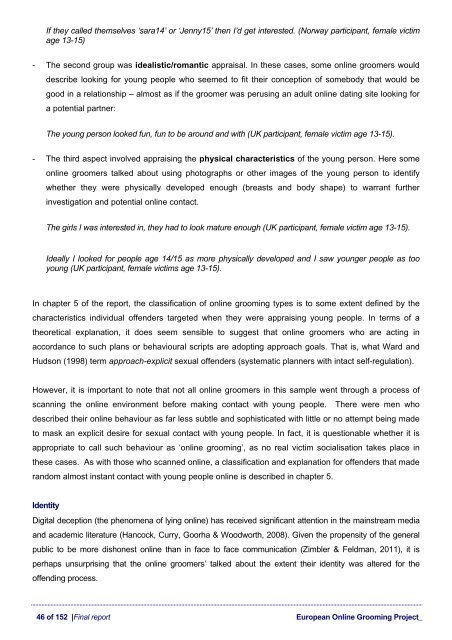Final Report - European Online Grooming Project
Final Report - European Online Grooming Project
Final Report - European Online Grooming Project
Create successful ePaper yourself
Turn your PDF publications into a flip-book with our unique Google optimized e-Paper software.
If they called themselves ‘sara14’ or ‘Jenny15’ then I’d get interested. (Norway participant, female victim<br />
age 13-15)<br />
- The second group was idealistic/romantic appraisal. In these cases, some online groomers would<br />
describe looking for young people who seemed to fit their conception of somebody that would be<br />
good in a relationship – almost as if the groomer was perusing an adult online dating site looking for<br />
a potential partner:<br />
The young person looked fun, fun to be around and with (UK participant, female victim age 13-15).<br />
- The third aspect involved appraising the physical characteristics of the young person. Here some<br />
online groomers talked about using photographs or other images of the young person to identify<br />
whether they were physically developed enough (breasts and body shape) to warrant further<br />
investigation and potential online contact.<br />
The girls I was interested in, they had to look mature enough (UK participant, female victim age 13-15).<br />
Ideally I looked for people age 14/15 as more physically developed and I saw younger people as too<br />
young (UK participant, female victims age 13-15).<br />
In chapter 5 of the report, the classification of online grooming types is to some extent defined by the<br />
characteristics individual offenders targeted when they were appraising young people. In terms of a<br />
theoretical explanation, it does seem sensible to suggest that online groomers who are acting in<br />
accordance to such plans or behavioural scripts are adopting approach goals. That is, what Ward and<br />
Hudson (1998) term approach-explicit sexual offenders (systematic planners with intact self-regulation).<br />
However, it is important to note that not all online groomers in this sample went through a process of<br />
scanning the online environment before making contact with young people. There were men who<br />
described their online behaviour as far less subtle and sophisticated with little or no attempt being made<br />
to mask an explicit desire for sexual contact with young people. In fact, it is questionable whether it is<br />
appropriate to call such behaviour as ‘online grooming’, as no real victim socialisation takes place in<br />
these cases. As with those who scanned online, a classification and explanation for offenders that made<br />
random almost instant contact with young people online is described in chapter 5.<br />
Identity<br />
Digital deception (the phenomena of lying online) has received significant attention in the mainstream media<br />
and academic literature (Hancock, Curry, Goorha & Woodworth, 2008). Given the propensity of the general<br />
public to be more dishonest online than in face to face communication (Zimbler & Feldman, 2011), it is<br />
perhaps unsurprising that the online groomers’ talked about the extent their identity was altered for the<br />
offending process.<br />
46 of 152 |<strong>Final</strong> report <strong>European</strong> <strong>Online</strong> <strong>Grooming</strong> <strong>Project</strong>_


